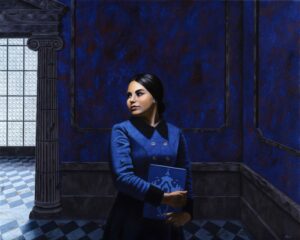Homiens Winter 2024

Mátyás Zsolt Sárosi, Our feet took root (detail), 2023, Acrylic and acrylic ink on canvas, 39.4” x 39.4” (1000 mm x 1000 mm).
The Homiens Art Prize is Closing Soon
Nelson
In my mother’s dimple, 2023
Filmed performance (00:03:08)
Artist’s Statement: In my mother’s dimple is a short, filmed performance which explores the potential for separate metaphorical archives held within the bodies of a mother and child, recording something of the other and reflected in their face, mind and actions. It examines what such an archive could contain and how each might use it as both a holding place of, and a site of exploration for, their individual identities. As part of the auto-theoretical tradition, this film considers the theories of Jerome Bruner on the formation of the self, of Roszika Parker on maternal ambivalence, Lucy Jones on Matrescence and Astrida Neimainis on hydrofeminism. How are these theories lived through the bodies of a mother and child and what might they tell us about how we understand ourselves through the gaze of those we love? This film is positioned at the intersection between academic theory, filmmaking, visual contemporary art, memoir, and the body as material.
Nelson (she/her) is a contemporary conceptual artist based in London and currently studying for an MFA at the Royal College of Art. At the core of Nelson’s practice is storytelling and the murkiness of the “truth” of one’s recollections. She considers her work an ongoing labour of ascesis, or self-discipline, an elaboration of the self by the self. Her practice embodies radical vulnerability through a combination of object, text and film, but always with the visible presence of the artist’s hand at work as a performative enactment of her subjectivity. Nelson’s work, therefore, often plays with the mess, leakage, and imperfections innate in the human experience. She is interested in the abject and often mixes uncomfortable visual metaphors with dark humour, believing that this will make the work resonate longer with the viewer. Nelson considers her work part of the auto-ethnographic and auto-theoretical traditions – she uses episodes from her own story as the source of her work, believing it will yield insights about broader contemporary culture. She invites the audience to use the visual interpretations of her experiences as a springboard to explore their own. Nelson’s work has been exhibited internationally, including a 2023 screening of her short film “He.., I…” at a Tate Late event at Tate Modern, the broadcasting of a sound piece on “Montez Press Radio”, and inclusion in physical and digital exhibitions held by “Woman Made Gallery” in Chicago. Nelson has work in the “Procreate Project Archive” and won the Batsford Prize Fine Art Category in 2022.
Giordano Biondi
Dead Ghosts (#14), 2022
Single edition digital print on photographic paper
11.4” x 16.5” (290 mm x 420 mm) from Dead Ghosts
Artist’s Statement: The Dead Ghosts series portrays translucent vessels as ghostly apparatuses which express the dual, ambiguous dialectic between the animate and the inanimate. Using a digital scanner, these delicate architectures, composed by miscellaneous material, create the illusion of three-dimensional objects in a nondescript nocturnal space. The title of the series plays on absurdity: Can a ghost, an entity that exists beyond life, be defined as dead? Does that mean that the dead can die again in the afterlife? Perhaps an infinite process is at play, where the spirit dies and reappears in ever deeper otherworldly planes, or perhaps a dead ghost is simply an inanimate entity which does not ever appear again as an agent with intention.These compositions seeks to keep the tension between these different interpretations open, and the representation of the limitless and the limited jostling within the depiction of the supernatural object.
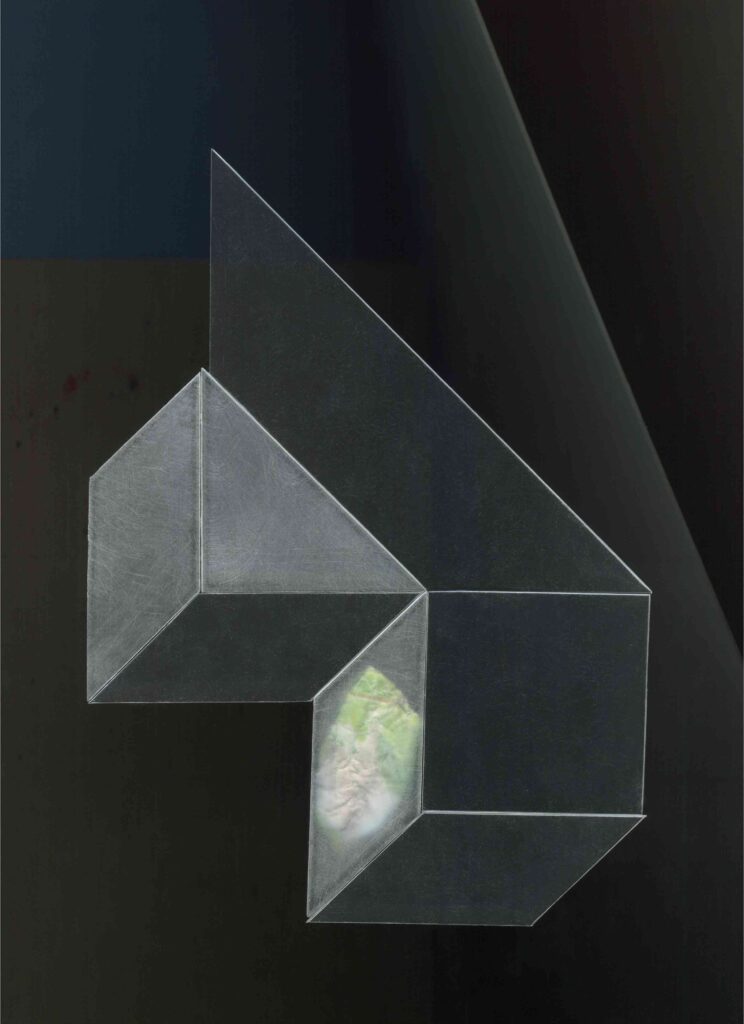
Giordano is a Melbourne-based Italian-Australian visual artist. He attended Visual Arts and Theatre at IUAV University in Venice, and finished a Masters in Art in Public Space at RMIT in Melbourne. He started his art practice in Venice and has participated in exhibitions in Australia and Italy. He participated in an artist residencies in Turkey, Germany and China, producing solo and collaborative public art installations, and has curated group shows in Melbourne, Venice, Perugia and Milan. He is currently represented by West End Art Space in Melbourne. His art practice is based on reflection upon architectural and landscape elements which define and distort our perception of individual and collective uses of public space. Lately, Giordano has focused on cityscapes and depicting ideal landscapes as narratives which invite the gaze to linger on every one of their components. Each house and palace is the locus of an encounter or an idea, expressed through the peculiarity of its architecture. The whole picture is then an alphabet or an archive into which the gaze consults, travels, or finds refuge and solace. these fictional cities are intended as a sort of dream catcher for the eye, a portal to a remote land.
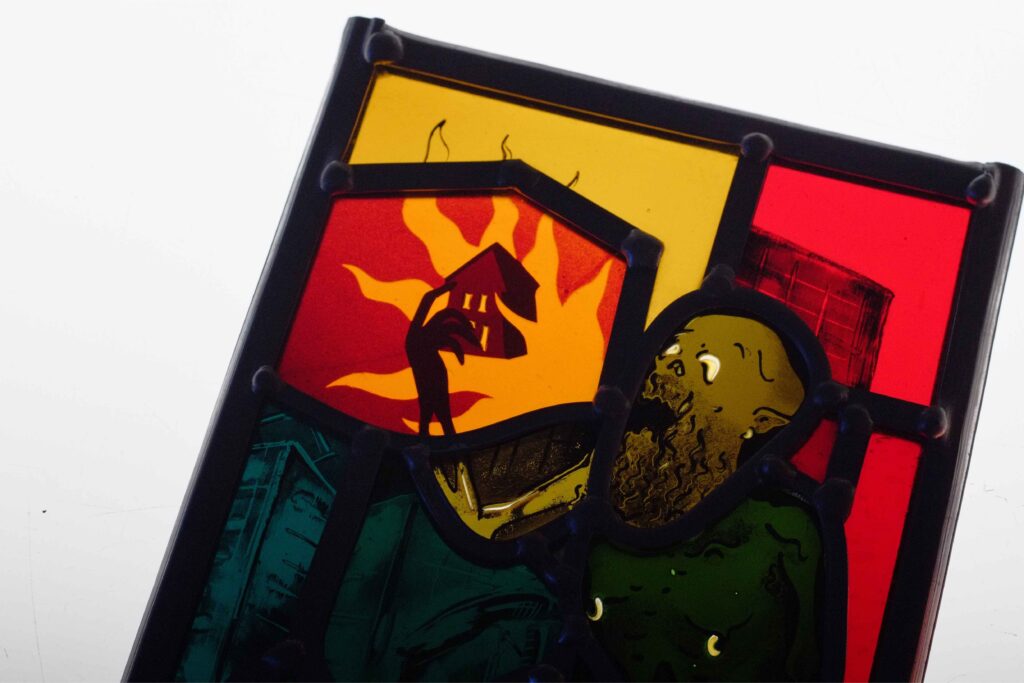
Kerry Collison
The Devil’s on the Streets of Swansea, 2023
Stained glass framed in oak
7.7″ x 5.3″ (195 mm x 135 mm, unframed)
Artist’s Statement: Made during the second winter of the cost of living crisis, this panel depicts a giant starving skeleton that reflects the ever increasing homeless population living in Swansea. The work addresses the morbidly laughable reality that it might just be easier to stay warm at night if you were set on fire by a giant demon walking the streets.
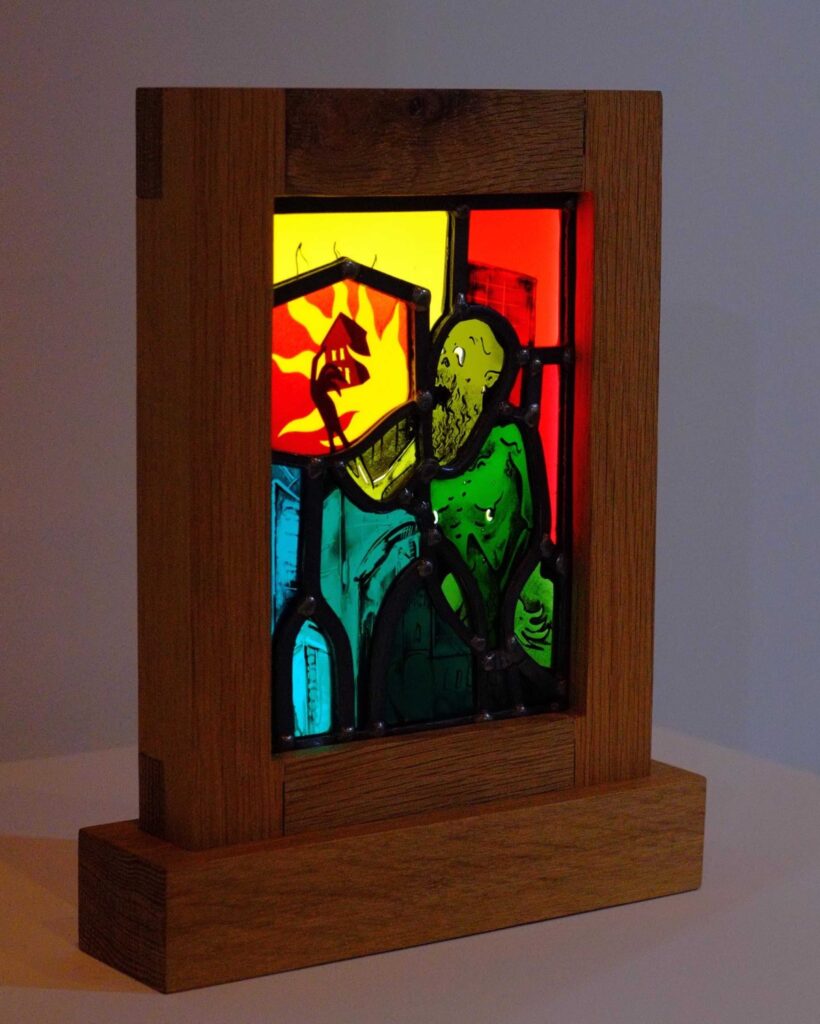
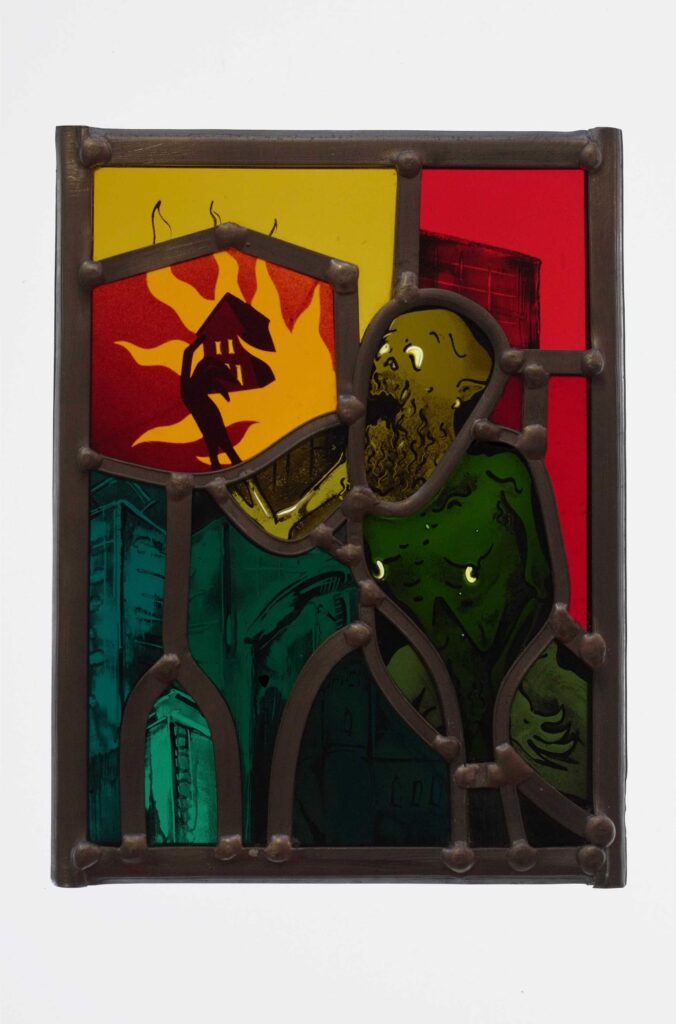
Traditionally trained in stained glass, sculpture and contemporary art foundry practices, I consider myself equal parts craft person and conceptual fine artist. I advocate technical and traditional craft skills and their application into the contemporary art environment. Pushing humour and naughtiness wherever appropriate, I believe that fine art becomes more accessible through comedic imagery and a slightly sarcastic inclination. My personal work illustrates mischief and anarchy confined into controlled glass material. Bringing the comic book back to its original format: the stained glass window.
Manuel Dampeyroux
The Book of Youssra, 2023
Oil on canvas
28.7″ x 36.2″ (730 mm x 920 mm)
Artist’s Statement: This is a psychological painting about the mystery of human soul.
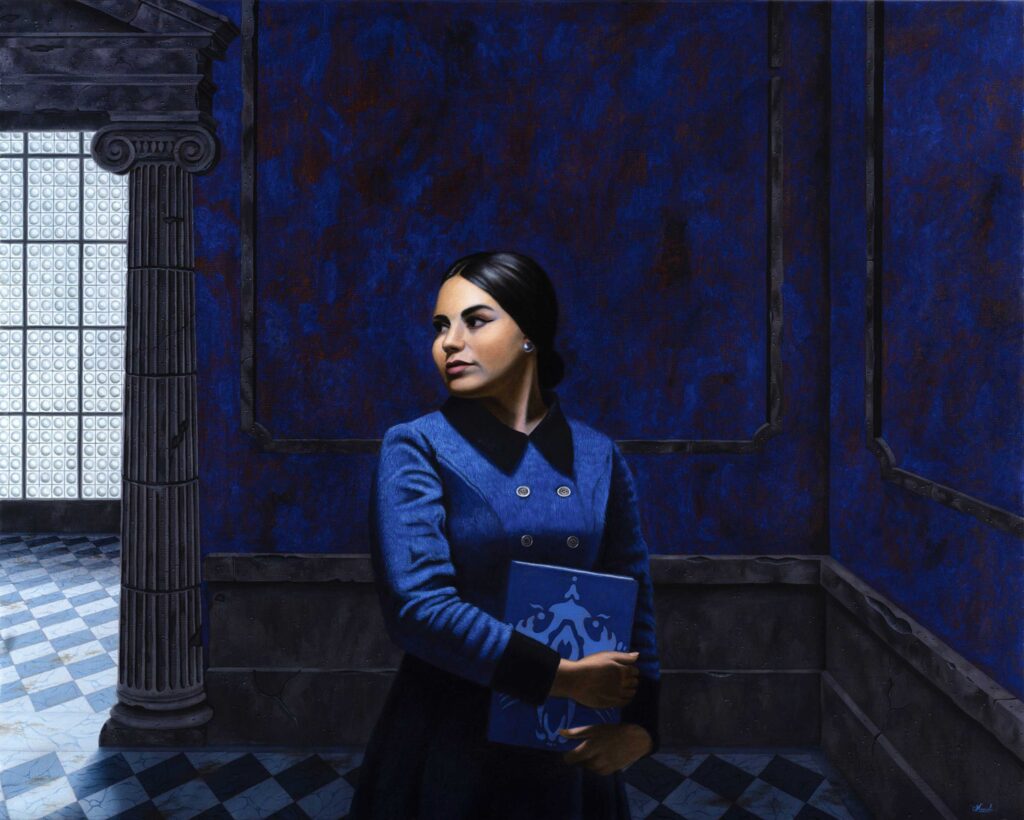
I was born in 1991 in Brazil. Currently living in Montpellier (France), I draw and paint in a singular way. I started creating when I was about 5. My first meaningful artistic influence came when I was 14, from New Hollywood movies. Ambiguity, the realistic vision of individuals and their problems, the willingness to explore the depths of the human soul and the use of antiheroes all stand out in my pictorial work. Graduated from University Paul Valery III in Montpellier and holding a master’s degree in contemporary visual arts, my personal artistic practice comes naturally on a daily basis. I feel artistic creation as a strong conviction, a passion. Jan Van Eyck, Edvard Munch, Vilhelm Hammershoi, Edouard Manet, Vermeer, Rembrandt, Caravage & Raphaël are major influences in my work. I also read poetry, especially from the latter half of the 19th century (Rimbaud-Baudelaire- Verlaine-Sully Prudhomme).
Kevin Driscoll
A monument to contemporary architecture, 2024
Cold-formed steel structural members, Code of Standard Practice, foam and spray paint on a wood plinth
47.2″ x 27.5″ x 118.1″ (1200 mm x 700 mm x 3000 mm)
Artist’s Statement: A monument to contemporary architecture calls attention to the cheap, almost ephemeral material quality of today’s architecture. The sculpture features thin columns that stand as frail descendants of the once strong and ornate stone columns of the past. As a memorial, it diverges from the expected overbearing weight and presence typically associated with such structures, yet it carries a significant presence in its own unique way. This sculpture mirrors the proportions of the first bedroom the artist had in Berlin. Its size represents what the square meter price of an “old” apartment contract would equate to in today’s market. Instead of relying on abstract numerical comparisons, the artist chooses to embody this change in a physical form. This approach allows viewers to visually grasp the weight of the current situation.
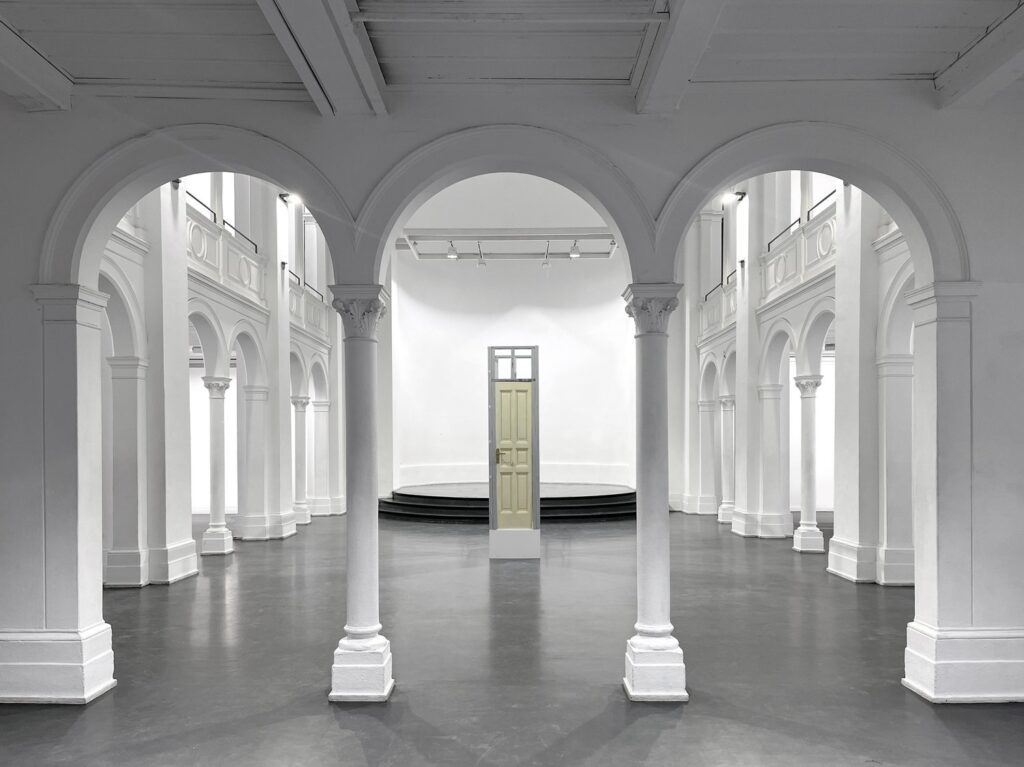

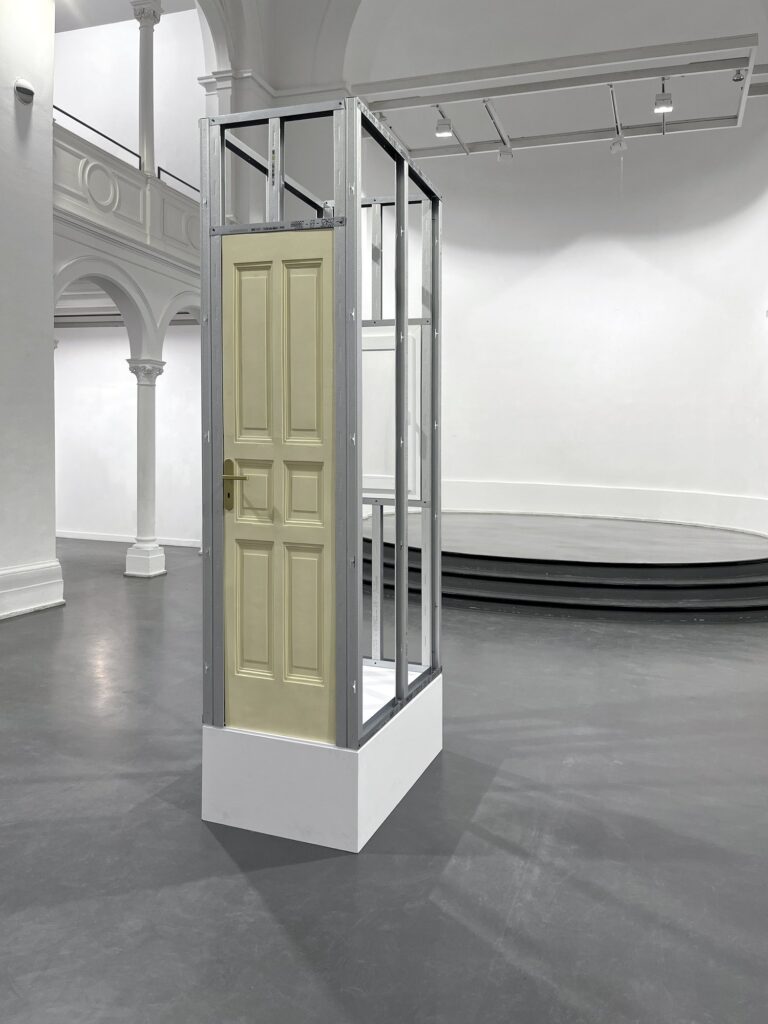
Kevin Driscoll (b.1987) is an artist originally from Boston, Massachusetts, who currently lives and works in Berlin, Germany. Driscoll’s practice revolves around the use of various construction techniques and architectural details as a way to rearticulate the physical world. Within his research, he aims to constantly learn, acquire new skills and become more familiar with materials and techniques that allow him to translate his ideas into physical works of art. Using his practice as a means of self reflection, his works often acknowledge the idea of emotional history embedded within materials and the unique associations they present for each viewer. His work celebrates the complexity of past and experience, in turn, leading us to reflect on our own journeys, injecting his works with our own meaning. By using common materials familiar to all viewers, Driscoll questions the morals of art and the importance put on seemingly useless objects as they compare to their functional counterparts seen throughout our cities as temporary inconveniences. Through this exploration, he seeks to highlight various details that are both essential and absurd in our built environment.
Kayley Jane Dykman
Kia’i Mana, 2022
Oil and acrylic on linen
28″ x 34″ (710 mm x 860 mm) from Pasifika
Artist’s Statement: At the beginning of my practice of incorporating flat textiles and quilt patterns, I decided to experiment with rendering a quilt design and pairing it with an abstracted textile. I thought this contrast of a condensed and abstracted element in the foreground could create interest against a fully rendered background and the traditionally rendered figure. I placed the entire composition within a “frame” or border. With the model’s pose, it appears as though he is protecting the quilt, symbolic of his culture, traditions, language, and mana. His gaze furthers this narrative as he directly confronts the viewer and makes them question their presence and authority within the picture. Hopefully, the viewer can extend this into their exploitation of Hawaiian peoples and land and their ignorance or compliance with their struggle.

Kayley, raised in Fountain Valley, California, is a representational artist who largely works in oil. As a Pacific Islander hapa—someone of mixed ancestry— she actively seeks to give authentic recognition (both on the canvas and behind) to underrepresented communities, heritage, and culture. Her current body of work, Pasifika, aims to celebrate and share Polynesian culture, arts, and experiences. At a young age, Kayley began Polynesian dancing, which has since opened her eyes to Pacific island cultures. Because of this and her fascination with the natural environment and traditional arts, her work incorporates portraiture alongside vibrant colors, crafts, ora, fauna, arts, and customs familiar to the Pacific islands. In December 2022, Kayley graduated from Laguna College of Art and Design with a Bachelor of Fine Arts in Drawing and Painting and a minor in Art History. In addition to other recognitions, Kayley was the youngest exhibiting artist at the 2023 Festival of the Arts in Laguna Beach. Kayley is also a recipient of the Plotkin Foundation Award and an honorable mention in the National Portrait Society’s 2023 and 2024 Future Generation Competition. Now a graduate, Kayley is transitioning into her studio practice at home in Fountain Valley.
Wenhui Jiang
Act Heterosex, 2023
Digital work (00:02:47)
Artist’s Statement: Act Heterosex is an experimental digital short film unfolding through the perspective of a first-person player in the gaming world. The narrative explores the impactful struggles faced by China’s young LGBTQ+ community, dealing with intense pressure and violence due to traditional heterosexual family expectations. Consequently, they are compelled to abandon their true sexual orientation in favour of conforming to heterosexual relationships. Within the portrayed societal context, queer individuals find themselves coerced into marriages and parenthood, with the expectation of upholding the family lineage to be seen as dutiful children in the eyes of their parents. Based on my experiences as a queer individual in China, the story reflects the marginalization of our sexual orientation in mainstream society. we’re compelled to compromise our identity, conforming to heteronormative rules. We’re the overlooked particles in a cis-heteronormative society, existing but hidden. The film sheds light on the deteriorating living conditions and unimaginable challenges faced by China’s queer community. It aims to spotlight mental, physical health, and survival issues in the young queer community through a tragic, ironic narrative.
Wenhui Jiang (b.1996) is a London-based visual artist who works with multi-disciplinary subjects and media. She recently graduated with an MA in experimental communication from the Royal College of Art (London, UK). Wenhui is fascinated by using visual fictionalization and world-building as methods to experiment with critical storytelling. She uses the philosophy of pessimism as a lens filter for observing the outside. In Wenhui‘s research and practice, She takes herself as the object of observation. To see herself as an open container, from which he explores the definition and transformation of individual identities in the entanglement of interaction with the outside world. Wenhui uses her work as a tool to research the impact of the era and society behind the individual. In addition, science fiction, Cult films, and video games had a profound influence on Wenhui’s visual language. During her MA study, Wenhui used gamification as a further exploration of an experimental narratives model. Her work is focused on creating a communication model of cryptic visual narrative, combining symbolic and chaotic quirky visual aesthetics which aim to build an uncanny dimension, and encourage the viewer to rethink reality.
Lorella Paleni
Dwellers 4, 2021
Oil and oil pastels on linen canvas
64.9″ x 57.8″ (1650 mm x 1470 mm) from Dwellers
Artist’s Statement: I work with painting, drawing, monotype, and traditional hand-painted video animation. I direct a particular interest in the use of a technique combining superposition and transparency, thus revealing moments of dichotomy and duality. My artistic research investigates various subjects I greatly connect to, including ecology, women, nature, and the relations between humans and animals. Animals are our fellow dwellers in this world and have the peculiar power to question man about her/his own humanity. We share many things in common with them and yet we feel so distant. I seek to create images that blur this distance. I found that the gaze somehow reduces the alienation between different beings. The moment two subjects look into each other’s eyes, a sudden proximity is created, a connection. Few things can be as intense and unsettling as the feeling of someone silently staring back into your own eyes. As the animal looks back at us language suddenly fails. There are similarities between the way women and animals are and have been viewed and treated. For centuries, women have been considered only partially human: too irrational, wild, and uncontrollable; weak and dangerous at the same time, something to be tamed. The witch has historically been seen as bestial, often accompanied or in proximity with animals. It is with this in mind that I started a series of portraits representing alleged witches, through the depiction of women I know, artists and friends.
I start each painting with a general idea that gets slowly shaped and can sometimes greatly diverge at its completion. It is important to me that the process be open to possibility and change. Painting itself becomes, in its making, a space of possibility for the unplanned and unexpected to happen—an open space that welcomes the intruder and the foreign, the untamed, the non-human.

Lorella Paleni is an Italian-born artist currently living and working in Paris. Using painting, monotype, photography, and traditional video animation she investigates various subjects including ecology, women, nature, and the relations between humans and non-human animals. She received her MFA from Columbia University and her BFA from the Academy of Fine Arts of Venice (IT). Recent exhibitions include solo show at Galéria Mesta Levoča in Slovakia, at Galerie de L’OpenBach in Paris, E.Tay Gallery in New York City, Magic Beans Gallery in Berlin and at the HB55 Kunstfabrik in Berlin; she has been featured in numerous group exhibitions in the United States, Europe and India. Paleni has completed residencies with the Indo-European Residency Project in Kolkata; Catwalk Institute, Catskill, NY; Le CouveNt, Ausitz, France; AZ West with Andrea Zittel, Joshua Tree, California; and the Wassaic Project, Wassaic, NY
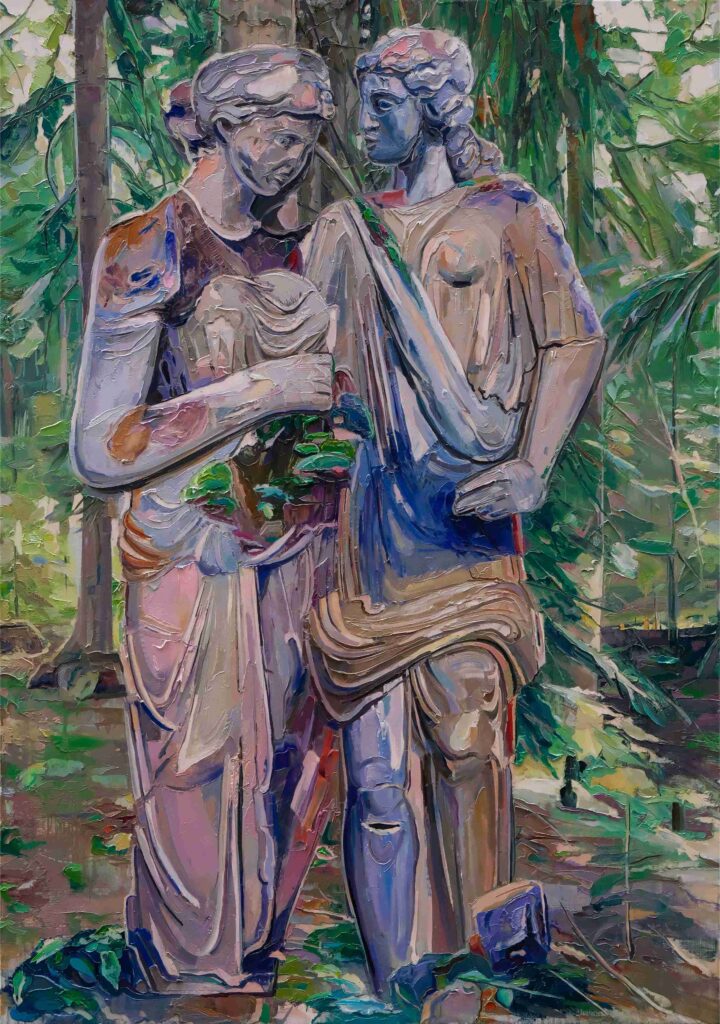
Burcu Perçin
Solidarity, 2022
Oil on canvas
66.9” x 47.2” (1700 mm x 1200 mm)
Artist’s Statement: The figures I reference from antiquity are in the wilderness, as a part of it. These figures, who love nature without any self-interest and view it as a sacredness, live in harmony and solidarity not only with nature but also among themselves.
Burcu Perçin draws attention to social and environmental topics in her works. From abandoned warehouses to marble quarries, she emphasizes that it is not only nature that is lost but that it is also the future of humans that is lost. Perçin, who creates her visual narrative through a unique aesthetic language, considers unemployment and poverty brought about by globalization in industrial settings and shines a light on areas where people are more lonesome. One of her main topics is the artificial landscape created by humans. She brings together old and new forms of man-made construction in nature in her works, reminding us that past cultures and lives will bring light to our future, by blending the matters of our day with history and nature in her works. While integrating antique sculptures with nature, she uses abstract and real denotations together. Perçin opens up a new window to her artistic practice in her thoughts on nature through these works. The artist also expresses herself through sculpting and photography disciplines, alongside painting. Her photo-collages, oil on photography, relief works composed of natural stones, and sculptures which refer to antiquity show a strong parallel connection with her paintings.
Alexander Warncke
Trees and Rocks, the Shapeshifter, 2023
Fineliner pen on rough paper
15.7″ x 15.7″ (400 mm x 400 mm)
Artist’s Statement: Nature was originally discovered as a place of resources. From it, humans created tools and built structures to suit their needs. As humans began to reshape nature in more technical and alterable ways, architecture drifted further away from its origins, leaving it disconnected from the earth. Depicted is the essence of architecture: nature reformed. Rock flattened so you can walk on it. A tree carved so you can hang things from it. Wood cut to provide shelter. As we reshape materials based on their innate characteristics, letting wood be tall and light, and rock heavy and hard, we remain connected to the earth.

Alexander Warncke is a Swedish artist living in Germany. He works mainly with pen and paper, and oil paints. While studying architecture at the Technical University of Kaiserslautern, he was given a teaching position in “artistic form and ideas” and “urban design”. He is currently working on an exhibition of oil paintings called “Where Man Meets Nature”.
Arthur Dantes Porto Lara
Ubik Series, 2023
(Ubik Window, Ubik Hallway, Ubik Stairs)
Digital paintings
16.5” x 23.4” (420 mm x 594 mm)
Artist’s Statement: We spend so much time emotionally sedated. Aimlessly wandering solitary dreamscapes. Through this collection, I aim to illuminate the horizon and highlight alternative paths. The endless tug of war between darkness and light offers a way out.


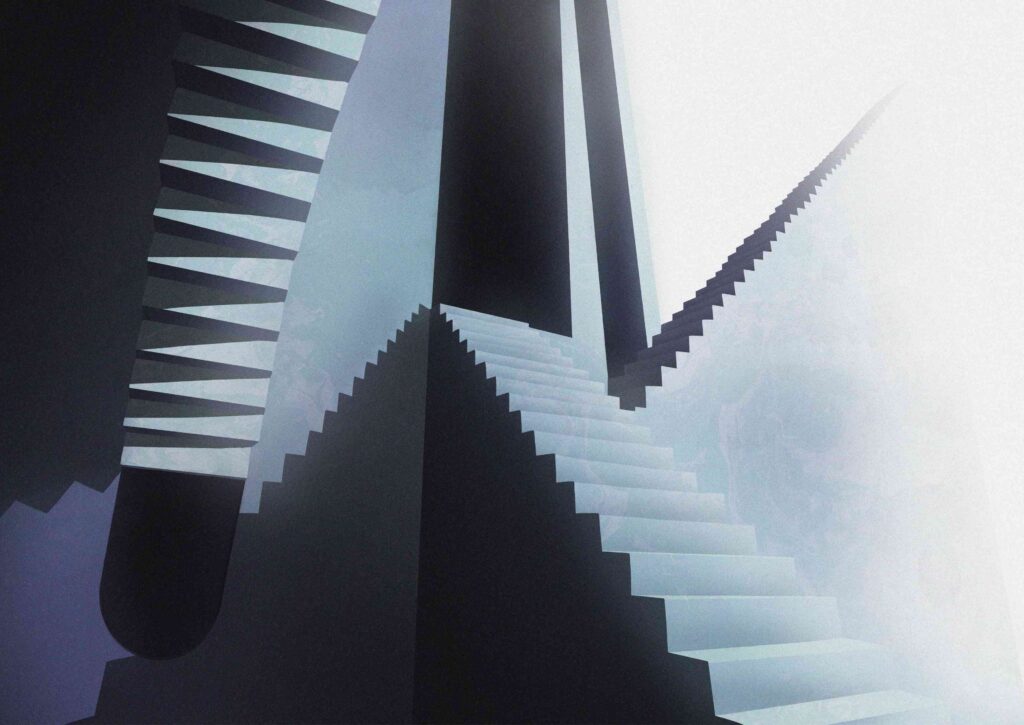
Born and raised in Brazil, Arthur Dantes is a fine artist with a passion for surreal landscapes. Arthur’s passion for art eventually led him to study in England, where he currently lives and works. The galleries which have exhibited his work so far include: The Holy Art Gallery, The Boomer Gallery, Fox Yard Studio, and Saint Louis Art Gallery. His biggest influences are Alejandro Jodorowsky, David Firth, and Jesse Moynihan.
Adrienne Hein
February, 2024
Acrylic on canvas
48″ x 60″ (1219 mm x 1524 mm)
Artist’s Statement: February delicately explores the poignant theme of losing innocence in the passage from youth to maturity. The luminous backdrop serves as a metaphor for the brightness and optimism inherent in youth, a time when the world is a canvas of endless possibilities. The net of red woven across the top layer introduces a sense of complexity and veiled vulnerability, representing the loss of innocence that often accompanies the inevitable journey into adulthood. The interplay of colors suggests that this loss of innocence is not a stark departure from brightness but rather an intricate blending of contrasting emotions—a symphony of transition. The work invites viewers to reflect on their own journeys through the lens of youthful naivety giving way to a more nuanced understanding of the world. It prompts contemplation on the sacrifices and challenges inherent in the process of maturation, emphasizing the bittersweet beauty that emerges from the contrast between the complex background and intense blanket of red.
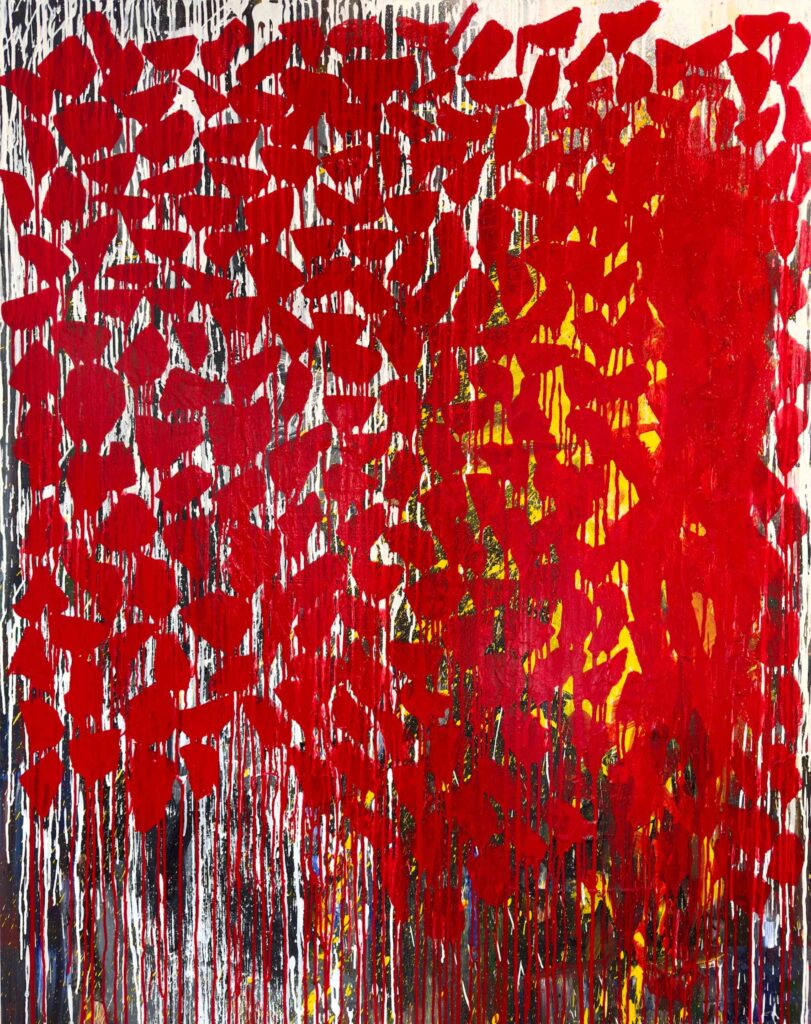
Adrienne Hein is a 21 year old, self-taught contemporary artist born and raised in Northwest Indiana. In 2021, Adrienne made Los Angeles her home and set up her studio following her decision to depart from studies as a psychology student. Dedicating herself fully to her artistic practice since then, she has been engaged in an exploration of abstract design and large-scale acrylic paintings. Adrienne’s path to becoming a professional artist is underway as she has just started to search for her place in the art world. Her first solo exhibition was hosted in June of 2023, followed by her participation in a number of group exhibitions. Recently, she traveled to France to further explore her artistic practice at a remote creative residency. Through these experiences she has pushed the boundaries of her creativity, experimenting with new techniques and approaches. In her most recent work, Adrienne’s artistic voice has become even more distinct and consistent. Her development as an artist is moving exponentially and she promises to stand out amidst the sea of emerging talent. She feels very excited for the future she will create for herself, whatever it may look like.
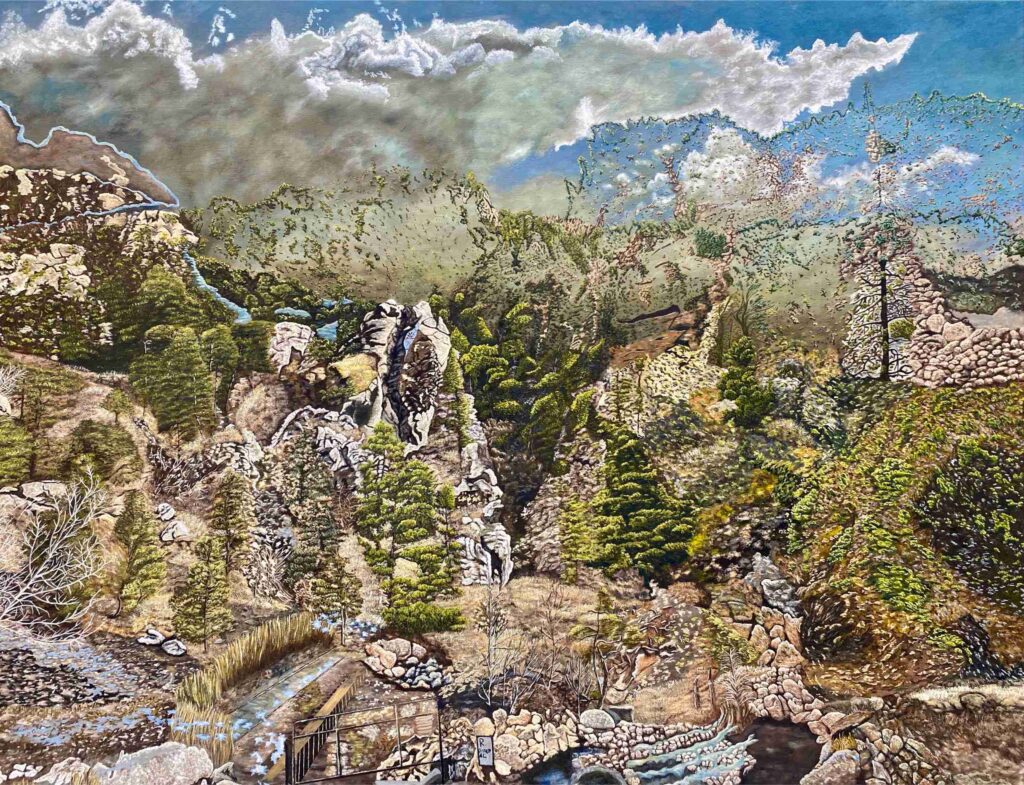
Raoul Orzabal
The Rockies, 2022
Oil on canvas
37.4” x 29.5” (950 mm x 750 mm)
Artist’s Statement: Painted between March and August 2022, The Rockies shows the fragmented composition of a view of a canyon within the Rocky Mountains. Like the rest of my recent work, I created the painting reference by merging a series of photographs I took while I was out in the mountains. To overlap the imagery, I faded one over the other or used cut out effects to reveal layers beneath. Once the reference was complete, I then copied every inch of its detail down in oil paint onto the canvas. I had travelled out to the Rockies in December 2021 for a trip and to experience its wintery climate. Despite the freezing temperatures they were above average and snowfall was also low for this time of year. It wasn’t what I expected, as the painting was planned to have a wintery feel, but instead showed the more arid dry nature of the landscape. This led me to research the impact of climate change in the area and what I found out was that the climate of the Rockies was one of many areas changing the most quickly. Its location just west of the main Tornado Alley and high altitude is also contributing to its transformation. This lead me to show honesty within the painting’s colour, arranging its multi viewpoint perspective to imitate erosion and systemic collapse.
I originally grew up just outside of Bristol and moved to London in 2012 to attend art school. I had an interest in creating art from and early age but by the time I reached my final year of sixth form I decided I wanted to be an artist. The decision came after researching Art History that year and learning its evolution and different concepts. This encouraged me to attempt creating my own art, inspired by taking elements in periods throughout Art History and merging them together. Self-expression was my overriding motivation. Other areas I was interested in moving into were Architecture and History; however, the emphasis in these was mainly mathematical and written work, which were of less interest to me. Fine Art represents aesthetics, my first priority, so with that, and in conjunction with my interest in design, it became clear that painting was where I could develop my imagination. I began by mainly creating digital imagery on the computer but I felt painting was closer to the original physical object. After graduating from art school in 2016, I dedicated myself to working on single paintings, which would take months to complete. Using my latest techniques I have attempted to create my own form of landscape paintings influenced by Classical and Romantic styles, featuring painterly detail on a similar scale. My landscape designs present a large-scale multi viewpoint perspective with even hints of objects seen floating in the sky. My work usually ranges from minimal to highly decorative in appearance with strong contrasts and movement. The concept’s response to Classical painting is that viewpoints are invented and resemble stealth Cubism. My series shows more of a truth with the fragmented landscape as they are easily recognised with their different perspectives.
Michael Pemberton
Tools By The Pool (after Hockney), 2023
Oil on canvas
35” x 45.7” (890 mm x 1160 mm)
Statement: “And indeed the river-god saw his love in the water, and putting off the shape of a man he had assumed, he changed back to his own watery form, and mingled with mine.” – Ovid’s Metamorphoses Book I (A. S. Kline’s translation, c. 1903). We linger in Hockney’s iconic California idyll in [Michael Pemberton’s] Tools by the Pool (After Hockney), where we can find the octopus’s magenta knife being clutched on the shoulder of a green-eyed male figure. This cheeky reference to the double entendre of a tool – simultaneously a functional device and phallic euphemism – draws our attention to the central object at hand: a pair of mustard yellow scissors held by a partially hidden woman. Again, a denotation of duality pervades – domestic instrument, sex position – and begs the questions of how we use tools: for care, for harm, for protection, for or against each other? This couple – lovers, twins, or the duality of self, from a double-headed serpent to Dr. Jekyll and Mr. Hyde – is in direct reference to Titian’s Venus & Adonis from his Poesie commission. In this epic mythological painting we find the entwined couple in a state of motion, Venus falling backwards, clutching her lover desperate for him not to go out hunting to his death – Adonis lunging forward, balancing upon feathered spear alluding to the cupid’s arrow that originally pierced our heroine’s heart. ‘My wonder,’ muses the artist, ‘is at Titian’s ability to make flesh from oil, have us suffer the longer we look and perhaps most impressively bring death to life.’ In all of the paintings in the new series, there is an uncanny and cinematic sense that something is about to happen, that we are on the brink of a fundamental change. This is a Western art historical no-no, for it is deemed inadvisable, if not forbidden, to leave so much to the imagination, so much on the brink of transformation. Yet in persistent allusion and ode to Ovid, the artist relishes in this rule-breaking, welcoming our agency as audience. Just as we may have initially questioned the identity of this pair, we may now ask if they are a couple fighting, or pre-emptively grieving? And in the context of the Splash, in its crown- like configuration about the pair creating, forming Gothic arches with a cross at its core, we wonder if this exchange of fluids is an allusion to deep intimacy – a becoming one? Or is the preoccupation with tools, limbs engaged and strained, an allusion to eminent drowning, and death.
Statement provided by Katherine Finerty, Curator, Writer, Educator, and Project Curator in International Partnerships at Tate.
Photographer: Aurelien Mole
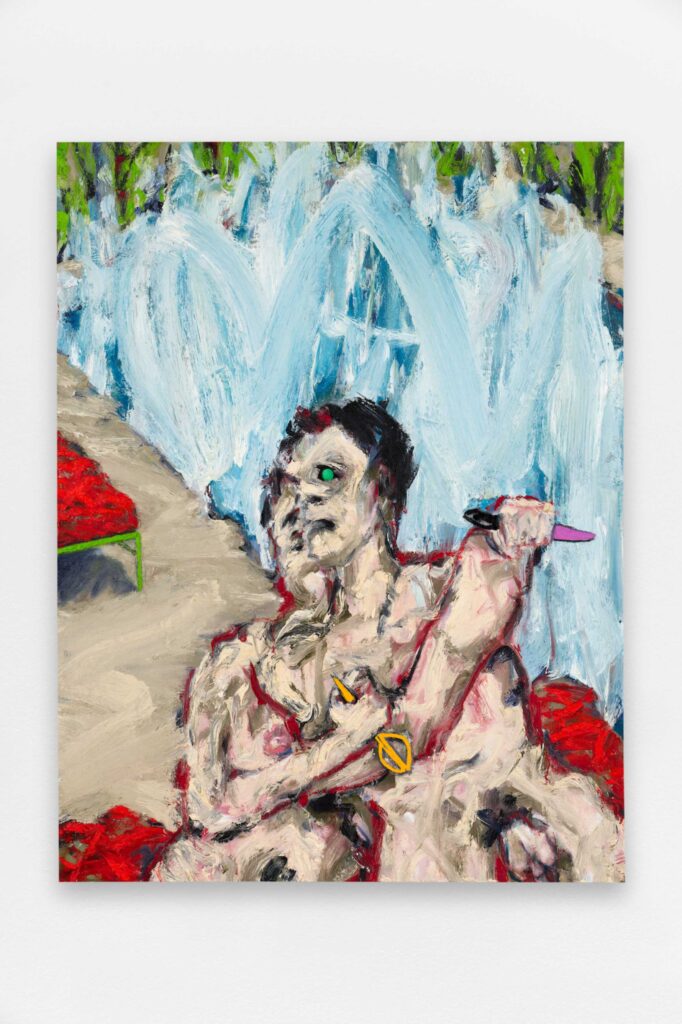
Michael Pemberton (b. 1974, UK) is an artist, painter. Over a twenty-year painting career, Pemberton has had group and solo exhibitions in galleries in London, Paris, Los Angeles, Mexico City and Vancouver. The first twelve years of Pemberton’s practice was largely abstract investigations. Concerns about climate change in 2003 led to his first solo exhibition of paintings, The Toxic Series, in 2006 in London. Over the subsequent ten years, Pemberton lived and worked in New York and Los Angeles. He explored questions of internal and external journeys, ambiguity and indefinability. These investigations resulted in abstract paintings on canvas and works on paper. Solo and group exhibitions of this work were held in 2016, 2017, 2018 at galleries in Los Angeles and Vancouver. In 2018, Pemberton addressed physical human form in his work. He aimed to bring about a sensation of human believability and interpretable feeling in the imaginary works, yet avoiding the interference of realism. The resulting works on canvas and paper were grouped into four successive series and shown at solo and group exhibitions in 2021, 2022, 2023 in galleries in Paris, Mexico City & London. In 2023, solo exhibition in London The Age of Water catalogue essay was written by a curator at Tate. Today, Michael Pemberton paints self-invented works inhabiting imaginary surroundings obliquely influenced by the outside world we experience as a personal commentary of our present age. Though centered on humans and their activity, the diverse and challenging narratives exist with conflicts and links to other themes and motifs, and mix art historical references. Michael Pemberton was educated in Fine Arts at the Chelsea School of Art, London, and furthered his studies at UCLA, Los Angeles, the Ruskin School of Art, University of Oxford, and the Slade School of Fine Art, University College of London.
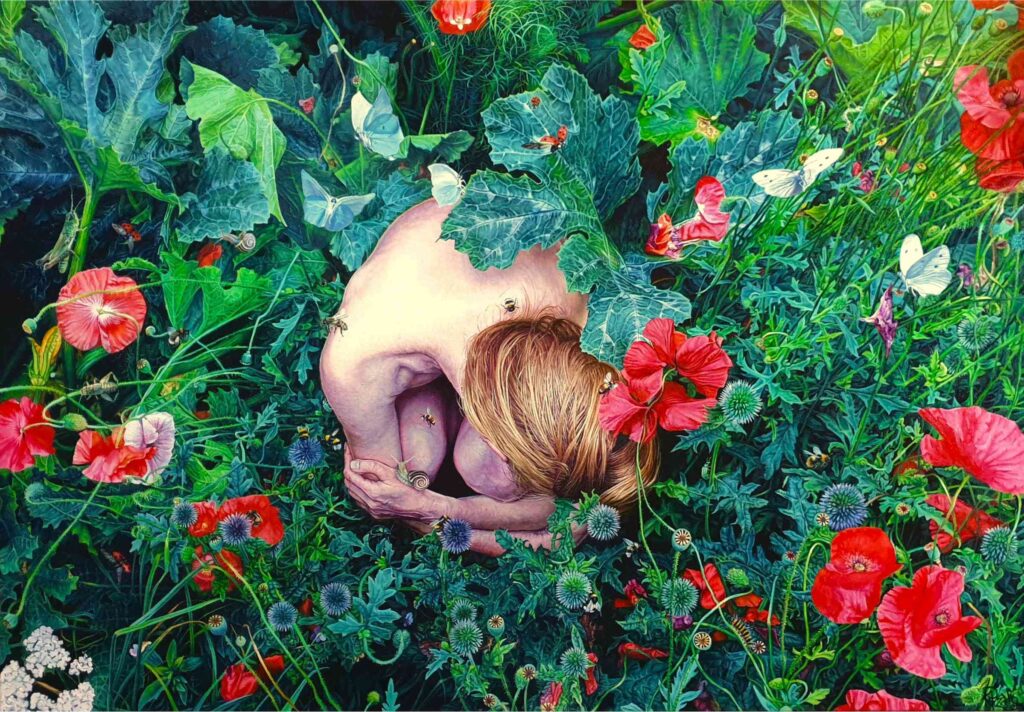
Kasia Przado
Everything Breathes Together, 2024
Oil on canvas
35.4” x 27.6” (900 mm x 700 mm)
Artist’s Statement: Kasia’s primary inspiration for Everything Breathes Together stems from the immediate natural world with which she endeavors to live in symbiosis. Through her art, she aims to cultivate a deep connection among all realms of nature, encompassing the human experience as well. She presents this interconnectedness as an inseparable and integral whole, endowed with beauty and a sense of sacredness. Everything Breathes Together stands as a response to the Green Transition, a term now sadly entangled with the advancement of new industries and technologies, primarily focused on expanding growth under the guise of supposed environmental care. However, many already intuitively recognize that the true essence of the Green Transition involves a profound shift in our consciousness, leading us to become participants in the Great Life rather than rulers. Just as the diversity of cells comprises the great living being, we, together with all living creatures, regardless of size or form, are integral parts of the Great Life experiencing itself through us. This understanding underscores that the true green transition, the one that can genuinely save us as a species, is not about adopting “greener” methods in exploiting the soil, rivers, and skies. It is about re-establishing our humble place in the sacred tapestry of life, so we can all breathe together in harmony, as it is meant to be.
Kasia Przado, a Polish-born artist born in 1985, has called Norway home since 2012. Presently, she resides and creates amidst the serene landscapes of Sekken, a small island nestled in the heart of a Norwegian fjord. While her formal artistic education led her to The School of Art in Seville, Spain, where she studied ephemeral architecture, her journey as a painter has largely been self-taught. Inspired by the breathtaking natural surroundings of her island sanctuary, Kasia’s work reects her deep connection to the environment and her ongoing exploration of its beauty and complexity. In addition to her artistic pursuits, Kasia is a practicing professional astrologer and has been a student of esoteric sciences for many years. Her passion for mysticism often shines through her paintings, which are endowed with symbolism that resonates with the soul. Her work “Radiant at Heart” was exhibited in the last London Art Biennale (2023). Kasia actively collaborates with the Higher Art Gallery (Michigan, USA), where she sold all her available works during the past year.
Mátyás Zsolt Sárosi
Our feet took root, 2023
Acrylic and acrylic ink on canvas
39.4” x 39.4” (1000 mm x 1000 mm)
Artist’s Statement: Plein air painting and drawing have been fundamental to my artistic development, therefore I have formed a profound attachment to the landscape, and nature has remained my perpetual inspiration. The root, or one might say the spark, of my work is the devastating forest fires that have become so frequent in recent years and are currently raging in many parts of the world, and therefore the analysis of the nexus between humanity and nature has become the focus of my work. My works combine surreal and hyper-realistic naturalism, human remains encoded in nature. Their intertwining reflects the inextricable ties between man and nature despite the rapid pace of technological and economic development. The surrealist elements distract the viewer from the streamlined proliferation of nature, and aim to associate it with real problems, ecological and humanitarian catastrophe. The only remedy for our self-loathing caused by the destruction of nature by our own hands is to return to the beauty that nature has to offer, to embrace it, to show all the wonders and splendor that nature has in store for us, from which we have been so conceited as to alienate ourselves. In an age when people tell themselves that an image “created” by a data-collection algorithm is art, creating by hand is perhaps more important than ever before – even if some of the artwork takes a week to create, and some can take more than a month. If we want to avoid people actually believing that the activity of a data-collecting algorithm that creates a mere spectacle, an empty surface, is really art, then the hand, that creates along with the human mind, soul, the tangibility of art, is more important than ever. Man’s greatest pride has always been to try to separate himself from the nature he scorned, but could never really control. He has fancied that he could put the crown on his own head by alienating himself from the nature in which he lives and trying to recreate it mechanically. He believed that he was moving away from reality towards utopia and was ultimately mired in dystopia: a burnt-out world without balance, burnt-out masses of people, treadmills, wars, environmental destruction, inequalities. But everywhere man has retreated, nature is taking over again. Metal, plastic, polycarbonate, but if we do not “clean it”, out of profound arrogance, moss, insects, grasses and all kinds of small animals will reappear. It is not possible to be alienated from nature: it is only a vain dream. Nature is within us, we are nature, from the smallest components of our cells to our most ambitious dreams of becoming disembodied, pure digital forms of consciousness, and of instantly believing ourselves to be immortal. Nature will nevertheless act on us in exactly the same way as before: our digital consciousnesses will have to be stored in some kind of medium, and that medium will invariably be subject to entropy.

Mátyás Zsolt Sárosi was born in 1985 in the small Transylvanian town of Kézdivásárhely. He graduated from the Ion Andreescu University of Art and Design, and then returned home to his hometown. He exhibits regularly in Transylvania in the form of group and solo exhibitions. Mátyás has been invited to the Netherlands In 2022, and participated in a group exhibition in the town of Maasluis, in the historic building named Douanehuisje. In 2020 he was asked to make an online exhibition for the Magyarság Házá, Budapest. The next year, Mátyás also had a solo exhibition in Budapest hosted by the Kárpát-haza Galéria. From 2023, he joined the young artists of GODOT Institute of Contemporary Art Budapest, and participated in their Art Fair and group exposition in 2023 and 2024. In the International Graphic Art Biennale of Szeklerland, he won a special prize in 2012. In the beginning of 2024 he participated in three international juried art competitions organized in the USA: the 11th Abstract competition Teravarna Gallery, and he received the Talent prize in the 2nd Nature competition also of the Gallery Teravarna based in Los Angeles. Earlier this year Mátyás received Second Prize Award in the Beautiful/Grotesque competition organized by Art-Collide North Carolina. In 2017 he was the co-founder and artist of Fantomatika comics publishing house. From 2018 to 2022, he was a comic strip artist for Előretolt Helyőrség literary magazine.

Lucas Stolz
Wabi Sabi, 2024
Sand, gesso, and acrylic on wood panel
20” x 20” (510 mm x 510 mm)
Artist’s Statement: Lucas Stolz’s process remains centered around the symbolic layering of words, figures, and calligraphy texts. His expressive use of fragmented words and images allude to his artistic practice grounded in the physical layering of inks and paints with white gesso. This layering method creates a monochromatic relief with soft hues bleeding through, before color is applied to the works from the side. This process exemplifies craftful techniques centered around the creation of texture, pattern, shape, and form. Often times, complementary colors are juxtaposed against one another in order to bring out a definitive color or bold sentiment, further highlighting the way in which color theory plays an integrative role in his creations. By combining traditional calligraphy practices, ones rooted for centuries in Asian and Arabic culture, along with vibrant pops of color and texture, his works exemplifies an innovative take on a classic art form. An element core to each of Lucas’ works stems from the way in which calligraphy is deciphered. Intentionally vague, the viewer must look to create their own meaning when examining Lucas’ works, highlighting how language, or the lack of initial translation from calligraphy to words, remains central to his artistic practice. This emphasis of connecting language and art directly captures the sentiment felt in the 1960’s of the well-established Art & Language group of European artists, working to define and bring meaning to Conceptual works of art which focused on the intersection of word and image. Lucas brings a fresh, twenty-first century approach to this idea of images as words and words as images, exemplifying the way layering, calligraphy, and color come together to create cohesive, identifiable works of art.
Lucas Stolz (b. 1985, Basel) explores the visual representation of words and their meanings by showcasing the intricate intersection of image and calligraphy. Currently based in Barcelona, Stolz’s work navigates the complex structures that exist between words as images and images as words. His artistic practice centers around the layering of motifs, symbols, and colors, ultimately creating dynamic, multi-sensory and complex works of art. Stolz has previously shown at Stroke Art Fair (Munich, 2022 & 2023), 22 Gallery (Munich, 2022), Open Art Group Show (2022, Barcelona), The Other Art Fair (2021), and Media Map Group Show (2012, Madrid). He completed his undergraduate studies in Visual Communication at the HfG Schwäbisch Gmünd in 2009 and his Postgraduate degree in Applied Illustration at IDEP Barcelona in 2010.
Touïs
On the road again! 2020
Etching
17.7” x 15.7” (450 mm x 400 mm)
Artist’s Statement: Vénus perdues au milieu de déserts abruptes châtient impitoyablement les nains de jardins qui la poursuivent de leurs assiduités. Fréquemment, un coin de route se détache et elles basculent dans le vide.

Touïs was born with a pencil in one hand and a brush in the other hand. His father, a Belgian surrealist painter showed him the way. Touïs has been killing time with passion of drawing, painting, etching and romping about until today at the age of 83 years old. With numerous publications in France and Belgium and a well-established career as a comic artist behind him, for the past 15 years Touïs has dedicated his daily life to painting and drawing. His favourite mediums are oil pastels, etching, and lately bic.

